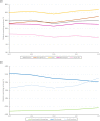Preventive Service Usage and New Chronic Disease Diagnoses: Using PCORnet Data to Identify Emerging Trends, United States, 2018-2022
- PMID: 38959375
- PMCID: PMC11230521
- DOI: 10.5888/pcd21.230415
Preventive Service Usage and New Chronic Disease Diagnoses: Using PCORnet Data to Identify Emerging Trends, United States, 2018-2022
Abstract
Background: Data modernization efforts to strengthen surveillance capacity could help assess trends in use of preventive services and diagnoses of new chronic disease during the COVID-19 pandemic, which broadly disrupted health care access.
Methods: This cross-sectional study examined electronic health record data from US adults aged 21 to 79 years in a large national research network (PCORnet), to describe use of 8 preventive health services (N = 30,783,825 patients) and new diagnoses of 9 chronic diseases (N = 31,588,222 patients) during 2018 through 2022. Joinpoint regression assessed significant trends, and health debt was calculated comparing 2020 through 2022 volume to prepandemic (2018 and 2019) levels.
Results: From 2018 to 2022, use of some preventive services increased (hemoglobin A1c and lung computed tomography, both P < .05), others remained consistent (lipid testing, wellness visits, mammograms, Papanicolaou tests or human papillomavirus tests, stool-based screening), and colonoscopies or sigmoidoscopies declined (P < .01). Annual new chronic disease diagnoses were mostly stable (6% hypertension; 4% to 5% cholesterol; 4% diabetes; 1% colonic adenoma; 0.1% colorectal cancer; among women, 0.5% breast cancer), although some declined (lung cancer, cervical intraepithelial neoplasia or carcinoma in situ, cervical cancer, all P < .05). The pandemic resulted in health debt, because use of most preventive services and new diagnoses of chronic disease were less than expected during 2020; these partially rebounded in subsequent years. Colorectal screening and colonic adenoma detection by age group aligned with screening recommendation age changes during this period.
Conclusion: Among over 30 million patients receiving care during 2018 through 2022, use of preventive services and new diagnoses of chronic disease declined in 2020 and then rebounded, with some remaining health debt. These data highlight opportunities to augment traditional surveillance with EHR-based data.
Figures


References
-
- Virani SS, Alonso A, Aparicio HJ, Benjamin EJ, Bittencourt MS, Callaway CW, et al.; American Heart Association Council on Epidemiology and Prevention Statistics Committee and Stroke Statistics Subcommittee. Heart disease and stroke statistics — 2021 update: a report from the American Heart Association. Circulation. 2021;143(8):e254–e743. 10.1161/CIR.0000000000000950 - DOI - PubMed
-
- US Preventive Services Task Force. A & B recommendations. 2023. Accessed October 23, 2023. https://www.uspreventiveservicestaskforce.org/uspstf/recommendation-topi...
MeSH terms
LinkOut - more resources
Full Text Sources
Medical

